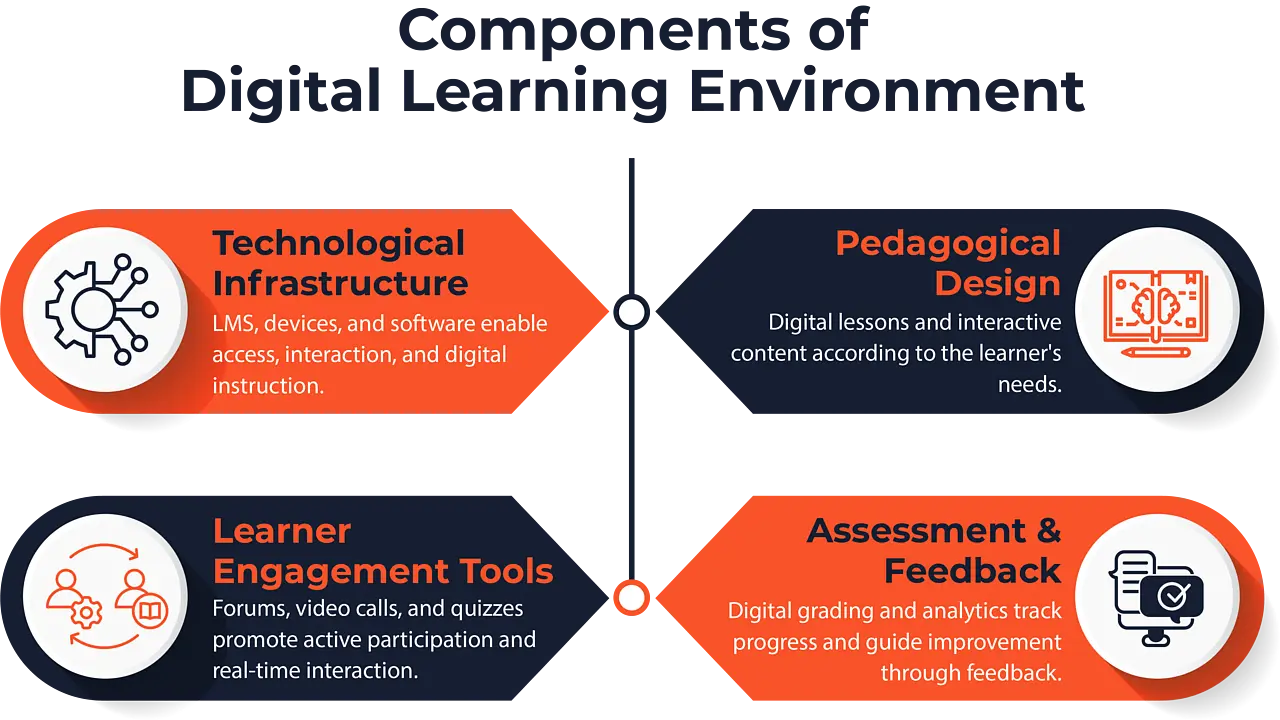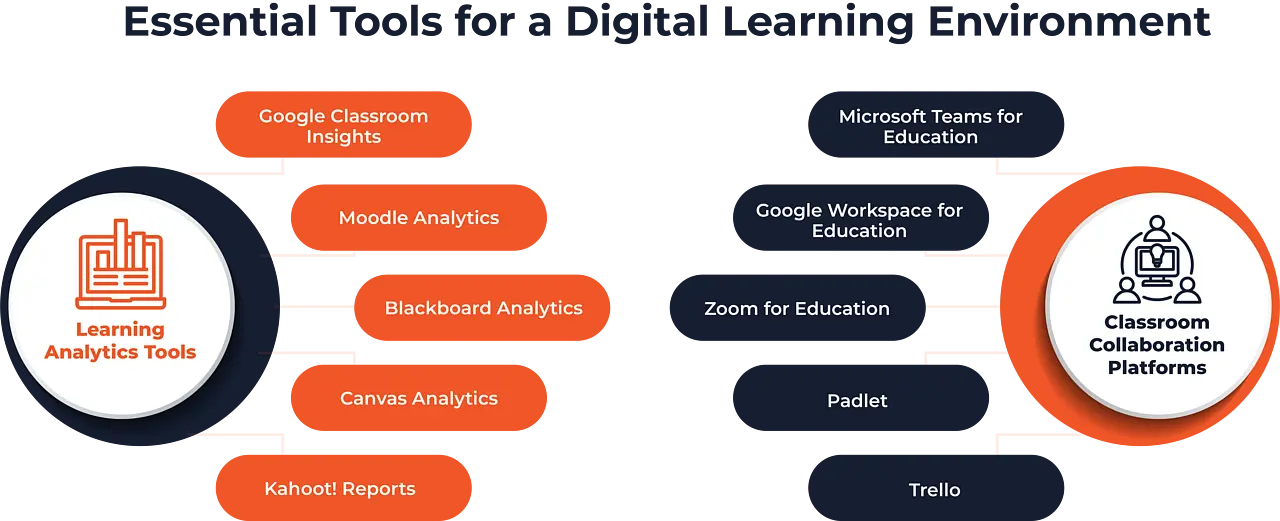The creation of a digital learning environment is integrated into modern teaching through teaching technology and tools that enhance interaction, accessibility, and engagement. Teachers now combine traditional methods with online platforms, multimedia resources, and virtual collaboration to support the diverse learning needs of their students.
Key Takeaways:
- Digital learning environments make education more accessible and engaging, helping teachers and learners adapt to modern teaching methods.
- Teachers benefit from digital tools that support flexible lesson delivery, real-time feedback, and inclusive practices, making learning effective and student-focused.
- Successful integration of technology requires addressing challenges by ensuring teaching and learning remain balanced, inclusive, and taking care of learners’ needs.
Digital learning environment (DLE) enables real-time feedback and personalised learning, provided teachers design assessments that are suited for digital platforms. It provides flexibility, making the learning process more inclusive and effective. Embedding digital pedagogy in teacher training enables trainers to confidently apply digital technologies in lesson planning, delivery, assessment, and classroom management.
This blog explains what a digital learning environment is and how it can be integrated into virtual classrooms.
What Is a Digital Learning Environment?
A Digital Learning Environment (DLE) is an online or blended space where digital tools are used to support teaching and learning. The purpose of DLE is to make education accessible, inclusive, and flexible for learners. The main idea is not to replace traditional teaching, but to enhance and extend it through the use of technology.
A digital learning environment integrates tools like virtual classrooms, multimedia content, cloud platforms, and interactive applications to support instruction, active participation, collaboration, and assessment.

What are the Skills Teacher Trainers Need in Establishing a Digital Learning Environment?
Trainee teachers need a range of digital skills to establish an effective digital learning environment. The essential skills include digital literacy, communication, classroom management, assessment, cybersecurity awareness, and adaptability, all of which are necessary to create inclusive, safe, and engaging online learning environments.
Digital Literacy
Teachers need to be confident with the use of digital learning tools and platforms. Digital literacy includes the knowledge of operating learning management systems such as Moodle or Google Classroom. Moreover, you must develop skills in creating engaging digital resources and integrating videos and quizzes into daily lessons. You also need to troubleshoot common issues and guide learners who face technical barriers.
Data Literacy
In digital pedagogy, understanding and using learner data is an essential skill. Teacher trainers must be able to interpret analytics from dashboards, progress trackers, and assessment tools to make informed decisions about teaching strategies. Data literacy involves recognising patterns, identifying learners at risk, and adjusting instruction to support individual progress. By using data responsibly, teachers can create more personalised, effective, and inclusive learning environments.
Communication Skills
To establish a strong presence in online learning spaces, teachers require practical communication skills. Clear and consistent interaction with learners through chat groups, emails, forums, or video calls helps learners stay engaged. You must develop skills to lead discussions, encourage collaboration among learners and manage virtual group projects.
Virtual Classroom Management
Managing a virtual classroom requires a structure. You must set clear rules and design interactive lessons to keep learners focused and engaged in the classroom. Trainers must also address screen time concerns, guide learners through digital etiquette, and provide emotional support in virtual spaces. The goal is a classroom environment where learners feel safe, engaged, and respected.
Assessment and Feedback
Teacher trainers need to create assessments that are compatible with digital formats. Using tools such as Google Forms, Kahoot, or Quizizz, you can design activities that track learning in real time. Learners can be provided with formative and summative assessments. Constructive feedback must be provided on time to support learners’ improvement. Analytics and dashboards make it easier to monitor progress and spot where learners need extra help.
Cybersecurity Awareness
Teachers must be aware of cybersecurity and digital fraud to protect learners’ data and ensure safe online behaviour for everyone. This involves safeguarding personal information and guiding learners on how to protect their data on online platforms. Promoting responsible use of technology, balancing the screentime and digital etiquette to make online learning safer.
Adaptability and Inclusivity
Due to the continuous innovation in digital platforms, teachers must be flexible in adjusting to new tools as well as the needs of learners. Ensuring that all learners have equitable access to learning opportunities and participation in class through digital tools and platforms. You must learn to provide an educational experience according to the learner’s needs.
Upgrade your teaching today.
Build your digital teaching skills with Diploma in Teaching (FE and Skills)
Enrol NowWhat Digital Technologies Do Trainee Teachers Need to Work Effectively in Contemporary Classrooms?
Trainee teachers need access to a range of digital tools that support interactive teaching and personalised learning. These tools prepare teachers to manage modern classrooms effectively while engaging learners in meaningful ways.
- Interactive Hardware: Interactive hardware enables learners to engage in dynamic lessons. Tools such as smartboards, tablets, and response systems help teachers move beyond static presentations by encouraging student input in real time.
- Virtual and Augmented Reality: Immersive technologies allow students to explore abstract or complex topics that might be difficult to grasp through textbooks alone. For example, virtual field trips let learners visit historical sites, while augmented reality overlays bring scientific processes to life. These experiences make learning memorable and build curiosity.
- Artificial Intelligence (AI): AI systems analyse learner progress and adapt content to suit individual strengths and weaknesses. For teachers, this means gaining real-time insights into how students are performing, enabling them to adjust their teaching strategies accordingly. AI also supports adaptive assessments and provides personalised recommendations, giving learners targeted support.
- Content Creation Tools: These tools help in designing engaging content and presentations for class activities. They can customise materials that align with their teaching style and learner needs. Using innovative digital tools, teachers can ensure that learners are engaged in class activities.
- Cloud-Based Solutions: Cloud-based tools, such as Google Workspace, facilitate easier collaboration on work projects. Learners and teachers will be able to access the shared material from anywhere, making remote learning easier. These tools provide a reliable space to store and organise resources.
- Gamification: Gamification tools make learning enjoyable by incorporating challenges, rewards, and progress tracking into daily lessons. It motivates learners, engages them in healthy competition, keeps them focused and encourages everyone’s participation.

Challenges You Can Face in Integration of a Digital Learning Environment
Digital learning environment made the learning process easier, but it does come with its own challenges.
Access to Technology
Modern tools that support a digital learning environment require updated hardware and software. Most learners and teachers lack access to the latest devices and a strong internet connection, creating a gap in digital learning.
Resistance to Change
Some teachers prefer traditional teaching and learning methods. They resist the shift to a digital system. This hesitation slows down the integration of new platforms and prevents classrooms from realising the benefits of digital learning.
Pedagogical Adaptation
Digital learning includes the integration of technology in lesson planning. Some teachers struggle with balancing the reliance on digital tools. They need to adapt their pedagogical skills to keep up with the digital advancements.
Safeguarding and Data Security
Digital classrooms introduce new risks related to privacy and learner safety. Sensitive data must be protected under strict regulations. Teachers must model safe online behaviour and ensure students know how to interact responsibly in virtual spaces.
Equity Concerns
Digital inequality is a serious concern in DLE. While digital learning environments have the potential to improve accessibility, this benefit is only realised if issues of inequality are addressed. Learners from unprivileged families often lack reliable devices or internet connections, and accessibility must be ensured so that those with additional needs do not feel excluded from the class.
Conclusion
A digital learning environment integrates technology, pedagogy, and engagement tools to strengthen modern teaching. Teachers must develop digital literacy, communication, classroom management, and cybersecurity awareness to manage inclusive and effective online classrooms. Access to interactive hardware, AI, cloud platforms, and gamification ensures dynamic learning experiences. However, challenges faced in a digital learning environment must be addressed. By applying the right skills and technologies, teachers can deliver engaging and safe learning that meets the needs of learners.





